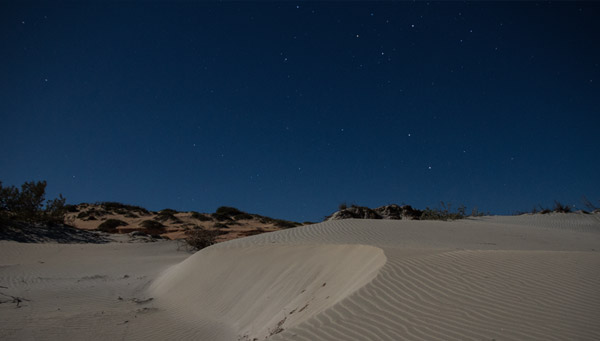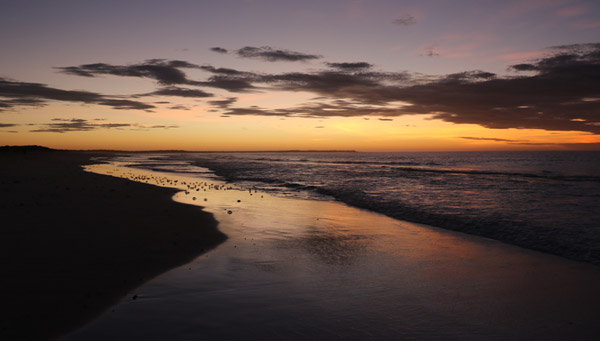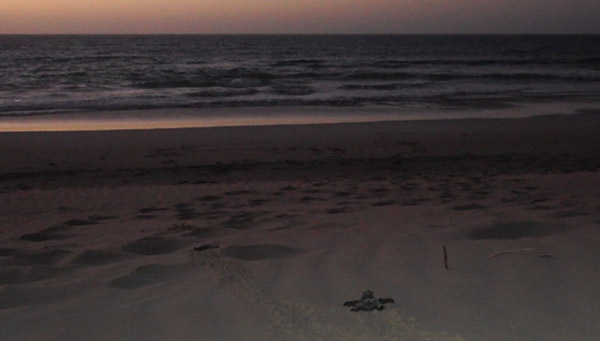
The night sky is part of the world’s oldest natural heritage
The Gnaraloo Wilderness Foundation supports the listing of Gnaraloo as a Dark Sky Reserve to recognize and protect its dark skies.


International Dark-Sky Association
The International Dark-Sky Association was created in 1988. The mission of the non-profit organisation is to protect the nights skies for present and future generations. The organisation works to actively spread awareness about night sky conservation to both the public and policymakers, whilst educating the public about alternative lighting tools to prevent and reduce light pollution to help restore Dark Skies across the globe.
Dark Skies at Gnaraloo
Here at Gnaraloo, we see the importance and benefits of having Dark Skies over wilderness areas.
We support Gnaraloo’s listing as a Dark Sky Reserve as it fulfills the requirements set out by the International Dark-Sky Association for such a reserve. This will also support the protection of the Gnaraloo Bay and the Gnaraloo Cape Farquhar Sea Turtle Rookeries.


Light pollution impacts a lot of species negatively by affecting their feeding, mating, migration and social behaviour.
Artificial lighting is increasing globally every year (Holker et al. 2010) and most countries are already affected by artificially brightened skies above natural background levels. Prolonged exposure to artificial light is a threat to biodiversity (Holker et al. 2010) and has led to unforeseen impacts on flora and fauna across the globe.
Light impacts on sea turtles
Research shows that light pollution alters animal behaviours such as mate selection, breeding cycles, foraging ranges, detection of resources and navigation (Davies et al. 2013).
During the breeding season, adult female sea turtles return to the beaches in the area where they were born to dig nests and lay their eggs generally during the night. They can be easily disrupted whilst digging their nests, or even discouraged from emerging all together, along busy touristic beaches with lots of movements and artificial lighting. This is detrimental to the survival of turtles. When disrupted during a nesting attempt, a turtle may decide to abandon the nest and re-emerge a few days later to nest again, using more energy than was initially needed which may negatively affect her during her long migratory journey back to her foraging and resting home grounds. Roughly two to three months after the female has laid her eggs, the hatchlings are ready to make their way to the ocean to start their new lives. As hatchlings depend on the natural light horizon to navigate their way to the ocean, artificial lighting on beaches causes many hatchlings to become disorientated, moving towards the bright lights rather than towards the ocean (Lorne & Salmon, 2007) and leading to their demise.


Light impacts on migrating birds
Migratory bird species have also been known to become disorientated and confused by the increasing light pollution along their natural migratory routes, with species that migrate nocturnally being especially affected (Verheijen 1958; Poot et al. 2008). A phenomenon known as positive phototaxis suggests that some species are attracted to the artificial lights and that both visual cues and a magnetic compass mechanism are used for orientation (Emlen, 1967; Emlen et al. 1976; Poot et al. 2008). Some scientific studies have found that birds were more attracted to the artificial lights on overcast nights than on clear nights as the birds could not use celestial cues, therefore depending more on magnetic compass orientation (Cochran & Graber, 1958; Avery et al. 1977; Evans Ogden, 2002; Poot et al. 2008). This has led to individuals straying far off course when they were attracted by large cities or offshore installations, leaving the individuals depleted of energy.
Large aggregations of migratory birds visit Lake MacLeod at Gnaraloo each year and may be impacted by artificial lighting.
References
Boldogh, S. Dobrosi, D. & Samu, P. (2007). The effects of the illumination of buildings on house-dwelling bats and its conservation consequences. Acta Chiropterologica, 9, 527–534.
Chepesiuk, R. (2009). Missing the Dark: Health Effects of Light Pollution. Environmental Health Perspectives, 117 (1), A20-A27.
Davies, T. W. Bennie, J. Inger, R. Hempel De Ibarra, N. & Gaston, K. J. (2013). Artificial light pollution: are shifting spectral signatures changing the balance of species interactions? Global Change Biology, 19, 1417-1423.
Downs, N. C. Beaton, V. Guest, J. Polanski, J. Robinson, S. L. & Racey, P. A. (2003). The effects of illuminating the roost entrance on the emergence behaviour of Pipistrellus pygmaeus. Biological Conservation, 111, 247–252.
Eisenbeis, G. (2006). Artificial night lighting and insects: attraction of insects to street-lamps in a rural setting in Germany. In: Ecological Consequences of Artificial Night Lighting (eds Rich, C. & Longcore, T), Island Press, Washington, 281–304.
Holker, F. Wolter, C. Perkin, E. K. & Tockner, K. (2010). Light pollution as a biodiversity threat. Trends in Ecology & Evolution, 25, 681-682.
International Dark-Sky Association. (2017). About, retrieved from; www.darksky.org/about/
Jones, G. & Rydell, J. (1994). Foraging strategy and predation risk as factors influencing emergence time in echolocating bats. Philosophical Transactions of the Royal Society B, 346, 445–455.
Limpus, C. J. (1985). A study of the loggerhead sea turtle, Caretta caretta, in Eastern Australia. Ph.D. Thesis, University of Queensland, St. Lucia, Queensland, Australia.
Lorne, J. K. & Salmon, M. (2007). Effects of exposure to artificial lighting on orientation of hatchling sea turtles on the beach and in the ocean. Endangered Species Research, 3, 23-30.
Pauley, S. M. (2014). Lighting for the human circadian clock: recent research indicates that lighting has become a public health issue. Medical Hypotheses, 10 (4), 588-596.
Poot, H. Ens, B. J. De Vries, H. Donners, M. A. H. Wernand, M. R. & Marquenie, J. M. (2008). Green light for nocturnally migrating birds. Ecology and Society, 13 (2), 47.
Ransome, R. D. (1989). Population changes of greater horseshoe bats studied near Bristol over the past twenty-six years. Biological Journal of the Linnean Society, 38, 71–82.
Rydell, J. & Racey, P. A. (1995). Street lamps and the feeding ecology of insectivorous bats. Symposia of the Zoological Society of London, 67, 291–307.
Schroeder, B. A. Foley, A. M. & Bagley, D. A. (2003). Nesting patterns, reproductive migrations, and adult foraging areas of loggerhead turtles. In: Loggerhead Sea Turtles (Eds Bolten A. B. Witherington, B. E.), 114-124. Smithsonian Books, Washington.
Stone, E. L. Jones, G. & Harris, S. (2012). Conserving energy at a cost to biodiversity? Impacts of LED lighting on bats. Global Change Biology.
Summers, J. K. Smith, L. M. Case, J. L. & Linhurst, R. A. (2012). A Review of the Elements of Human Well-Being with an Emphasis on the Contribution of Ecosystem Services. Ambios, 41 (4), 327-340.
Verheijen, F. J. (1958). The mechanisms of the trapping effect of artificial light sources upon animals. Archives Neerlandaises de Zoologie, 13, 1-107.
The information was compiled by Karen Hattingh, Simone Bosshard, Tessa Concannon, Tess DeSerisy, Heather Shipp and Megan Soulsby, 2017/18
Continue reading
Sea turtle conservation
The Gnaraloo Turtle Conservation Program protects nesting rookeries of endangered sea turtles on the Gnaraloo beaches.
Keep Gnaraloo Wild
We deeply believe that Gnaraloo should stay as it is, wild and undeveloped, to protect its biodiversity and wilderness experience.
